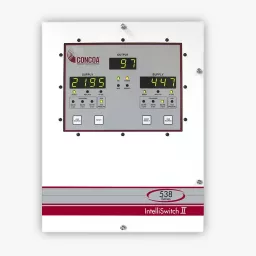Atomic absorption spectroscopy (AAS) is a technique for measuring the concentrations of metallic elements in different materials by atomizing the contents of a sample and then measuring the absorbance of a wavelength specific to that particular element in a gaseous state.
When a flame is used to atomize the sample, acetylene is the typical fuel, and air or nitrous oxide is the oxidant. Acetylene, a hydrocarbon widely used in industrial metal-working applications, is stored in liquid form as acetone that cannot be safely withdrawn from a cylinder at a pressure higher than 15 PSI (1 BAR.) CONCOA offers a special model of the 202 Series regulator designed for safe withdrawal, whether installed directly on the cylinder or safely mounted using a protocol station. For continuous supply or higher duty cycles, a 526 Series pressure differential switchover may be used. In all cases, a 532 Series high purity flashback arrestor is required to prevent ignition of the source in the unlikely event of combustion in the line.
Nitrous oxide is a refrigerant supplied in a liquid state of around 750 PSI (50 BAR), and the expansion associated with gaseous withdrawal at the rate required by AAS poses a significant threat of freezing. The CONCOA 308 Series regulator employs three 50-watt heaters specifically to counteract this effect. For continuous supply or higher duty cycles, a special 526 CD Series pressure differential switchover, also with integral heaters, may be used. As with all flammable gases, safe usage of acetylene or nitrous oxide in a laboratory requires storage and supply from a gas cabinet, which can be conveniently configured with 200 Series regulators or 526 Series pressure differential switchovers. Compressed air from a lab bench is often used as the oxidant, but if zero air cylinders are provided, the economical 212 or 312 Series regulator ensures no impurities such as moisture threaten the application.
If a graphite furnace is used to atomize the sample, the fuel and oxidant gases are not employed, but an inert gas, usually argon, is required to prevent combustion in the tubes. For withdrawal from a high pressure cylinder, CONCOA recommends a 212 Series regulator. In heavy-duty cycles, a cryogenic liquid cylinder of argon may be required. The 206 Series regulator with a protocol station is specifically designed for safe gaseous withdrawal from a cryogenic liquid source. For continuous use, the 526 LC Series supports cryogenic liquid cylinder primary sources with high pressure reserves. To supply multiple instruments or in a laboratory where atomic absorption spectroscopy is used alongside inductively coupled plasma spectroscopy, CONCOA strongly recommends the 538 or 539 Series intelliSwitch, which provides a continuous supply of gas safely and efficiently from two banks of cryogenic liquid cylinders.













